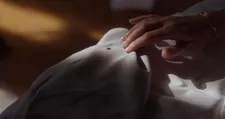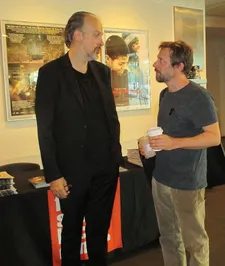![The Blue Room director Mathieu Amalric with Anne-Katrin Titze: "What is incredible is that, yes, the bee is in [George Simenon's] novel on the belly."](/images/newsite/The_Blue_Room_director_Mathieu_Amalric_with_Anne-Katrin_Titze_600.webp) |
| The Blue Room director Mathieu Amalric with Anne-Katrin Titze: "What is incredible is that, yes, the bee is in [George Simenon's] novel on the belly." Photo: Charlie Olsky |
Mathieu Amalric's The Blue Room (La Chambre Bleue), based on Georges Simenon's novel, stars Stéphanie Cléau, Léa Drucker with Serge Bozon, Mona Jaffart, Laurent Poitrenaux and Blutch. Amalric recently starred with Emmanuelle Seigner in Roman Polanski's Venus in Fur.
The morning after the North American premiere at the New York Film Festival, we discussed Simenon's love of Stendahl, leaving a message for composer John Zorn, Katharine Hepburn on a ladder, adapting Eric Reinhardt for the stage, William Holden's death in connection to David Lynch, Gene Hackman and Kevin Costner, bees and shoes.
 |
| Léa Drucker as Delphine Gahyde |
Vladimir Nabokov warned in Transparent Things "When we concentrate on a material object, whatever its situation, the very act of attention may lead to our involuntarily sinking into the history of that object." To remain in the here and now to truly focus on the surfaces is difficult.
A man, Julien Gahyde (Amalric), is bleeding at the lip. In rapture, his lover Esther (Cléau, who co-wrote the screenplay) bit him. "Your wife will ask questions," she says, and then "do you love me?" She is marking her territory in blood. Amalric uncompromisingly shows us the stains, the sweat, passionate embraces and a room as silent witness.
Mathieu Amalric boldly takes on the challenge with his adaptation of Simenon's novel La Chambre Bleue and makes it a thriller of membranes, a chronicle of fluid crime. He dares to go for big cinema moments while letting his audience the freedom to do the work of plot-telling on their own.
Anne-Katrin Titze: Last time we spoke was right before my conversation with Arnaud Desplechin at Lincoln Center during the 2013 New York Film Festival. You called yourself "actor as witness" and you showed me the United Nude shoes you had just bought in New York to take back to Paris.
Mathieu Amalric: I remember. I was just leaving a message for John. It's John Zorn who brought me to that shop.
 |
| Stéphanie Cléau and Mathieu Amalric on The Blue Room: "We were very faithful, Stéphanie and I, when we did the adaptation to keep those little things that we loved." |
AKT: One pair was a gift. Did they work out?
MA: The blue shoes. Yes. Stéphanie [Cléau, Amalric's partner and co-screenwriter for The Blue Room, who also plays Esther] didn't put them on. She used them for her play. We're on stage right now. Stéphanie directed and adapted a novel for theater.
AKT: Which novel?
MA: It's called Le Moral Des Ménages, a novel from maybe 15 years ago by Eric Reinhardt. He wrote Cendrillion and maybe will have the [Prix] Goncourt. She adapted that and we are touring in France. And in the decor there are clothes and shoes. Because the man has a sort of obsession with women's shoes.
AKT: And your United Nude shoes…
MA: They are there. She doesn't wear them.
AKT: I don't wear mine either, or very rarely. I have several pairs. They are more like architecture.
 |
| Stéphanie Cléau as Esther Despierre |
MA: They're beautiful shoes and very comfortable. I put them on when we were rehearsing.
AKT: You have the same shoe size?
MA: Well, as you can see in the film, she is very tall. These are shoes to wear when you love yourself. You have to be in a moment of confidence. And Stéphanie is not like that.
An airy empty room, blue and white. A rustic corridor in a rural hotel in France. Snapshots to take a quick look. It is summer. Objects tempt us to turn them into transparent things, as do the bodies that take over a bed.
AKT: She wears yellow strappy-shoes in The Blue Room. And you show them in the sun. Maybe strictly because of the colour, I connected them to the many bees in your film. It's an interesting way to link parts, the pollen, that fertilises things. You have the bee on the lover's belly, bee-sounds, the bee on the child's ice-cream and then the courtroom with a golden bee pattern on the wall. Talk about the bees!
MA: What is incredible is that, yes, the bee is in the novel on the belly. There is this beautiful notation by Simenon. We were very faithful, Stéphanie and I, when we did the adaptation to keep those little things that we loved. We almost wrote them in the script like he did, exactly the same sentences. He is very strong with the smells, the light, some gestures.
 |
| Gahyde family on holiday: "There is a moment where he gets angry with his daughter in a very nervous way and then again is very gentle." |
And there was this bee. It's very strange, because - that's where you can see that he was writing the novel in only 11 days - maybe 40 pages later, that bee becomes a fly. As if he forgot if it was a fly or a bee. So I was hesitating, is it a fly or is it a bee? The fly had more to do with the sperm, the sweat, something much more sexual. I chose the bee because I didn't have the courage to be too harsh.
AKT: The bees on the wall in the end have some fly resemblance.
A bee lands on Esther's belly. "I think so," is how he responds to her question. "Did she bite you often?" asks the Gendarme. Tip Top director Serge Bozon acts as the nameless uniformed interrogator and gives him a grave, scientific spirit of inquiry. What happened? Was there a crime?
MA: We shot the scene with the bee in July. It was very funny. Stéphanie [Cléau] was afraid.
AKT: You put her through torture?
MA: No. Because we did it with friends. She knew the DP [Christophe Beaucarne] very well, he is a friend and she loves him. And the sound engineer [Olivier Mauvezin] plays her husband [Nicolas Despierre] in the film. She chose her husband. The make-up girl [Delphine Jaffart] is her best friend. It's the mother of Mona [Jaffart], the girl who plays my daughter [Suzanne] in the film.
 |
| Mathieu Amalric's The Blue Room uncompromisingly shows us the stains, the sweat, passionate embraces and a room as silent witness. |
AKT: I interrupted your bee story. Please continue.
MA: There was this annotation when they were on holiday with the daughter and his wife. There is a moment where he gets angry with his daughter in a very nervous way and then again is very gentle. And I had this idea about the bee that could continue. When you see the big house, there's the sound of the bee. And the bees in the end, that's completely by chance.
AKT: You found the courthouse with the bees on the wall?
Symbolism adds layers to the storytelling - another blue room in a courthouse has golden bees marking the wallpaper which might be more on the nose to bring us full circle.
MA: My assistant showed me photographs of places. We were looking for a court, where the trial could take place. And I saw this and thought what is that? In fact, it was green before, because it came from Napoleon III, the second half of the 19th century. It was over time the yellow disappeared and it became blue. The bee is the sign of Napoleon I. That sort of saved me.
 |
| Mathieu Amalric with New York Film Festival Director of Programming and Selection Committee Chair Kent Jones Photo: Anne-Katrin Titze |
I wanted the film to finish in a way that they are sort of "on the other side". At the trial all those words would have no importance, they wouldn't hear them anymore as if they had no meaning. Nothing. Like the end of Le rouge Et Le Noir. That's why, in fact, he is called Julien.
AKT: Le rouge Et Le Noir is a project you have been working on, an adaptation of the Stendahl novel?
MA: Yes. What I didn't know was that Simenon loved Stendahl. Of course, this last scene is so close to the feeling that Julien Sorel has looking at those girls with hats.
AKT: The language you use in the courtroom is also very modern all of a sudden. These are real people pulling you.
MA: Yes, the witnesses are pulling you to reality.
In part 2, Mathieu Amalric discusses the quality of Serge Bozon's voice, William Holden's death in connection to David Lynch and Gene Hackman, RKO movies and how his reaction changed since Cannes.
The Blue Room opens in New York on October 3 and will be screened at the London Film Festival on October 15.





















